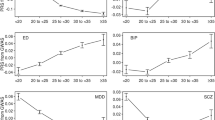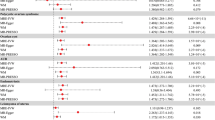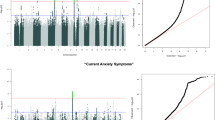Abstract
Reproductive behaviors are associated with risks for psychiatric disorders. Reproductive phenotypes are moderately heritable and have genetic overlaps with risks for psychiatric disorders. However, the genetic and causal relationships between anxiety-related disorders or specific anxiety disorders and reproductive phenotypes remain unknown. We utilized large-scale genome-wide association study (GWAS) results (n = 9537–542,901) for five reproductive phenotypes [age at menarche, age at first sexual intercourse (AFS), age at first birth (AFB), number of children ever born (NEB), and age at menopause] and five anxiety-related disorders [panic disorder, anxiety disorders from the ANGST and the UK biobank (UKBB), posttraumatic stress disorder (PTSD) and obsessive-compulsive disorder (OCD)]. To assess genetic correlations and causal associations, linkage disequilibrium score regression and Mendelian randomization analyses, respectively, were performed. We found that AFS and AFB were negatively correlated with anxiety disorders ANGST (AFS: rg ± SE = −0.28 ± 0.08, p = 6.00 × 10−4; AFB: −0.45 ± 0.11, p = 3.26 × 10−5), anxiety disorders UKBB (AFS: −0.18 ± 0.03, p = 9.64 × 10−9; AFB; −0.25 ± 0.03, p = 2.90 × 10−13) and PTSD (AFS: −0.42 ± 0.12, p = 4.00 × 10−4; AFB: −0.44 ± 0.12, p = 2.00 × 10−4) and positively correlated with OCD (AFS: 0.25 ± 0.05, p = 2.46 × 10−6; AFB: 0.25 ± 0.05, p = 3.92 × 10−7). Conversely, NEB was negatively correlated with OCD (−0.28 ± 0.08, p = 6.00 × 10−4). We revealed bidirectional effects between earlier AFS and AFB and anxiety disorders (odds ratios: ORearlier AFS→Anxiety = 1.64, p = 2.27 × 10−8; ORearlier AFB→Anxiety = 1.15, p = 2.28 × 10−3; ORAnxiety→earlier AFS = 1.02, p = 6.62 × 10−8; ORAnxiety→earlier AFB = 1.08, p = 1.60 × 10−4). In contrast, we observed unidirectional effects of later AFS and AFB on OCD (ORlater AFS→OCD = 2.18, p = 2.16 × 10−6; ORlater AFB→OCD = 1.22, p = 0.016). We suggest that those who have earlier sexual debut and childbirth are prone to risk for anxiety disorders and vice versa, while those who have later sexual debut and childbirth are genetically prone to risk for OCD. Our findings further support revising the diagnostic criteria (DSM-5) such that OCD is independent from anxiety disorders.
This is a preview of subscription content, access via your institution
Access options
Subscribe to this journal
Receive 12 print issues and online access
$259.00 per year
only $21.58 per issue
Buy this article
- Purchase on Springer Link
- Instant access to full article PDF
Prices may be subject to local taxes which are calculated during checkout





Similar content being viewed by others
References
Mills MC, Tropf FC, Brazel DM, van Zuydam N, Vaez A, Pers TH, et al. Identification of 371 genetic variants for age at first sex and birth linked to externalising behaviour. Nat Hum Behav. 2021;5:1717–30.
Elks CE, Perry JR, Sulem P, Chasman DI, Franceschini N, He C, et al. Thirty new loci for age at menarche identified by a meta-analysis of genome-wide association studies. Nat Genet. 2010;42:1077–85.
Perry JR, Day F, Elks CE, Sulem P, Thompson DJ, Ferreira T, et al. Parent-of-origin-specific allelic associations among 106 genomic loci for age at menarche. Nature. 2014;514:92–97.
Day FR, Hinds DA, Tung JY, Stolk L, Styrkarsdottir U, Saxena R, et al. Causal mechanisms and balancing selection inferred from genetic associations with polycystic ovary syndrome. Nat Commun. 2015;6:8464.
Rahmioglu N, Nyholt DR, Morris AP, Missmer SA, Montgomery GW, Zondervan KT. Genetic variants underlying risk of endometriosis: insights from meta-analysis of eight genome-wide association and replication datasets. Hum Reprod Update. 2014;20:702–16.
Mehta D, Tropf FC, Gratten J, Bakshi A, Zhu Z, Bacanu SA, et al. Evidence for genetic overlap between schizophrenia and age at first birth in women. JAMA Psychiatry. 2016;73:497–505.
Day FR, Helgason H, Chasman DI, Rose LM, Loh PR, Scott RA, et al. Physical and neurobehavioral determinants of reproductive onset and success. Nat Genet. 2016;48:617–23.
Mercer CH, Tanton C, Prah P, Erens B, Sonnenberg P, Clifton S, et al. Changes in sexual attitudes and lifestyles in Britain through the life course and over time: findings from the National Surveys of Sexual Attitudes and Lifestyles (Natsal). Lancet. 2013;382:1781–94.
Lara LAS, Abdo CHN. Age at time of initial sexual intercourse and health of adolescent girls. J Pediatr Adolesc Gynecol. 2016;29:417–23.
Pires R, Araújo-Pedrosa A, Pereira J, Canavarro MC. Preventing adolescent pregnancy: biological, social, cultural, and political influences on age at first sexual intercourse. J Prim Prev. 2014;35:239–54.
Polimanti R, Wang Q, Meda SA, Patel KT, Pearlson GD, Zhao H, et al. The interplay between risky sexual behaviors and alcohol dependence: Genome-Wide Association and neuroimaging support for LHPP as a risk gene. Neuropsychopharmacology. 2017;42:598–605.
Karlsson Linnér R, Biroli P, Kong E, Meddens SFW, Wedow R, Fontana MA, et al. Genome-wide association analyses of risk tolerance and risky behaviors in over 1 million individuals identify hundreds of loci and shared genetic influences. Nat Genet. 2019;51:245–57.
Mills M, Rindfuss RR, McDonald P, te Velde E. Why do people postpone parenthood? Reasons and social policy incentives. Hum Reprod Update. 2011;17:848–60.
Balbo N, Billari FC, Mills M. Fertility in advanced societies: a review of research: La fécondité dans les sociétés avancées: un examen des recherches. Eur J Popul. 2013;29:1–38.
Boivin J, Bunting L, Collins JA, Nygren KG. International estimates of infertility prevalence and treatment-seeking: potential need and demand for infertility medical care. Hum Reprod. 2007;22:1506–12.
Barban N, Jansen R, de Vlaming R, Vaez A, Mandemakers JJ, Tropf FC, et al. Genome-wide analysis identifies 12 loci influencing human reproductive behavior. Nat Genet. 2016;48:1462–72.
Loh PR, Kichaev G, Gazal S, Schoech AP, Price AL. Mixed-model association for biobank-scale datasets. Nat Genet. 2018;50:906–8.
Hettema JM, Neale MC, Kendler KS. A review and meta-analysis of the genetic epidemiology of anxiety disorders. Am J Psychiatry. 2001;158:1568–78.
Scaini S, Belotti R, Ogliari A. Genetic and environmental contributions to social anxiety across different ages: a meta-analytic approach to twin data. J Anxiety Disord. 2014;28:650–6.
Van Houtem CM, Laine ML, Boomsma DI, Ligthart L, van Wijk AJ, De, et al. A review and meta-analysis of the heritability of specific phobia subtypes and corresponding fears. J Anxiety Disord. 2013;27:379–88.
Shimada-Sugimoto M, Otowa T, Hettema JM. Genetics of anxiety disorders: Genetic epidemiological and molecular studies in humans. Psychiatry Clin Neurosci. 2015;69:388–401.
Kessler RC, Berglund P, Demler O, Jin R, Merikangas KR, Walters EE. Lifetime prevalence and age-of-onset distributions of DSM-IV disorders in the National Comorbidity Survey Replication. Arch Gen Psychiatry. 2005;62:593–602.
Kessler RC, Petukhova M, Sampson NA, Zaslavsky AM, Wittchen HU. Twelve-month and lifetime prevalence and lifetime morbid risk of anxiety and mood disorders in the United States. Int J Methods Psychiatr Res. 2012;21:169–84.
Tambs K, Czajkowsky N, Roysamb E, Neale MC, Reichborn-Kjennerud T, Aggen SH, et al. Structure of genetic and environmental risk factors for dimensional representations of DSM-IV anxiety disorders. Br J Psychiatry. 2009;195:301–7.
Monzani B, Rijsdijk F, Harris J, Mataix-Cols D. The structure of genetic and environmental risk factors for dimensional representations of DSM-5 obsessive-compulsive spectrum disorders. JAMA Psychiatry. 2014;71:182–9.
Maron E, Lan CC, Nutt D. Imaging and genetic approaches to inform biomarkers for anxiety disorders, obsessive-compulsive disorders, and PSTD. Curr Top Behav Neurosci. 2018;40:219–292.
Kupfer DJ. Anxiety and DSM-5. Dialogues Clin Neurosci. 2015;17:245–6.
Marras A, Fineberg N, Pallanti S. Obsessive compulsive and related disorders: comparing DSM-5 and ICD-11. CNS Spectr. 2016;21:324–33.
Otowa T, Hek K, Lee M, Byrne EM, Mirza SS, Nivard MG, et al. Meta-analysis of genome-wide association studies of anxiety disorders. Mol Psychiatry. 2016;21:1391–9.
Purves KL, Coleman JRI, Meier SM, Rayner C, Davis KAS, Cheesman R, et al. A major role for common genetic variation in anxiety disorders. Mol Psychiatry. 2020;25:3292–303.
Forstner AJ, Awasthi S, Wolf C, Maron E, Erhardt A, Czamara D, et al. Genome-wide association study of panic disorder reveals genetic overlap with neuroticism and depression. Mol Psychiatry. 2021;26:4179–90.
Arnold PD, Askland KD, Barlassina C, Bellodi L, Bienvenu OJ, Black D, et al. Revealing the complex genetic architecture of obsessive-compulsive disorder using meta-analysis. Mol Psychiatry. 2018;23:1181–8.
Tearne JE, Robinson M, Jacoby P, Allen KL, Cunningham NK, Li J, et al. Older maternal age is associated with depression, anxiety, and stress symptoms in young adult female offspring. J Abnorm Psychol. 2016;125:1–10.
Kingsbury AM, Plotnikova M, Clavarino A, Mamun A, Najman JM. Social adversity in pregnancy and trajectories of women’s depressive symptoms: a longitudinal study. Women Birth. 2018;31:52–8.
McGrath JJ, Petersen L, Agerbo E, Mors O, Mortensen PB, Pedersen CB. A comprehensive assessment of parental age and psychiatric disorders. JAMA Psychiatry. 2014;71:301–9.
Chang Z, Lichtenstein P, D’Onofrio BM, Almqvist C, Kuja-Halkola R, Sjölander A, et al. Maternal age at childbirth and risk for ADHD in offspring: a population-based cohort study. Int J Epidemiol. 2014;43:1815–24.
Ozcan NK, Boyacıoğlu NE, Enginkaya S, Dinç H, Bilgin H. Reproductive health in women with serious mental illnesses. J Clin Nurs. 2014;23:1283–91.
Salas-Wright CP, Vaughn MG, Ugalde J, Todic J. Substance use and teen pregnancy in the United States: evidence from the NSDUH 2002-2012. Addict Behav. 2015;45:218–25.
Bellack AS, Morrison RL, Wixted JT, Mueser KT. An analysis of social competence in schizophrenia. Br J Psychiatry. 1990;156:809–18.
Yasuyama T, Ohi K, Shimada T, Uehara T, Kawasaki Y. Differences in social functioning among patients with major psychiatric disorders: Interpersonal communication is impaired in patients with schizophrenia and correlates with an increase in schizotypal traits. Psychiatry Res. 2017;249:30–4.
Zhu Z, Zheng Z, Zhang F, Wu Y, Trzaskowski M, Maier R, et al. Causal associations between risk factors and common diseases inferred from GWAS summary data. Nat Commun. 2018;9:224.
Smith GD, Ebrahim S. ‘Mendelian randomization’: can genetic epidemiology contribute to understanding environmental determinants of disease? Int J Epidemiol. 2003;32:1–22.
Ni G, Amare AT, Zhou X, Mills N, Gratten J, Lee SH. The genetic relationship between female reproductive traits and six psychiatric disorders. Sci Rep. 2019;9:12041.
Duncan LE, Ratanatharathorn A, Aiello AE, Almli LM, Amstadter AB, Ashley-Koch AE, et al. Largest GWAS of PTSD (N=20 070) yields genetic overlap with schizophrenia and sex differences in heritability. Mol Psychiatry. 2018;23:666–73.
Bulik-Sullivan BK, Loh PR, Finucane HK, Ripke S, Yang J, Patterson N, et al. LD Score regression distinguishes confounding from polygenicity in genome-wide association studies. Nat Genet. 2015;47:291–5.
Ohi K, Shimada T, Kataoka Y, Yasuyama T, Kawasaki Y, Shioiri T, et al. Genetic correlations between subcortical brain volumes and psychiatric disorders. Br J Psychiatry. 2020;216:280–3.
Ohi K, Otowa T, Shimada M, Sasaki T, Tanii H. Shared genetic etiology between anxiety disorders and psychiatric and related intermediate phenotypes. Psychol Med. 2020;50:692–704.
Davies NM, Holmes MV, Davey Smith G. Reading Mendelian randomisation studies: a guide, glossary, and checklist for clinicians. BMJ. 2018;362:k601.
Hemani G, Tilling K, Davey, Smith G. Orienting the causal relationship between imprecisely measured traits using GWAS summary data. PLoS Genet. 2017;13:e1007081.
Hemani G, Zheng J, Elsworth B, Wade KH, Haberland V, Baird D, et al. The MR-Base platform supports systematic causal inference across the human phenome. Elife. 2018;7:e34408.
Ohi K, Otowa T, Shimada M, Sugiyama S, Muto Y, Tanahashi S, et al. Shared transethnic genetic basis of panic disorder and psychiatric and related intermediate phenotypes. Eur Neuropsychopharmacol. 2021;42:87–96.
Sabetnejad Z, Assarian F, Omidi A, Najarzadegan MR. Effectiveness of cognitive behavioral therapy and fluoxetine on sexual function of women with obsessive compulsive disorder: A double-blind randomized controlled trial. Electron Physician. 2016;8:3156–63.
Vulink NC, Denys D, Bus L, Westenberg HG. Sexual pleasure in women with obsessive-compulsive disorder? J Affect Disord. 2006;91:19–25.
Cousminer DL, Stergiakouli E, Berry DJ, Ang W, Groen-Blokhuis MM, Körner A, et al. Genome-wide association study of sexual maturation in males and females highlights a role for body mass and menarche loci in male puberty. Hum Mol Genet. 2014;23:4452–64.
Steinhausen HC, Jakobsen H. Incidence rates of treated mental disorders in childhood and adolescence in a complete nationwide birth cohort. J Clin Psychiatry. 2019;80:17m12012.
Biaggi A, Conroy S, Pawlby S, Pariante CM. Identifying the women at risk of antenatal anxiety and depression: a systematic review. J Affect Disord. 2016;191:62–77.
Martini J, Petzoldt J, Einsle F, Beesdo-Baum K, Höfler M, Wittchen HU. Risk factors and course patterns of anxiety and depressive disorders during pregnancy and after delivery: a prospective-longitudinal study. J Affect Disord. 2015;175:385–95.
Grauvogl A, Evers SM, Hoek K, Veen E, Franke A, van Lankveld JJ. Research into the efficacy and cost-effectiveness of brief, free of charge and anonymous sex counselling to improve (mental) health in youth: design of a randomised controlled trial. BMC Public Health. 2009;9:459.
Acknowledgements
We would like to thank all individuals who participated in this study.
Funding
This work was supported by Grants-in-Aid for Scientific Research (C) (19K08081, 21K07497, 22K07614) from the Japan Society for the Promotion of Science (JSPS) and a grant from the Smoking Research Foundation.
Author information
Authors and Affiliations
Contributions
KO supervised the entire project, collected the data, wrote the manuscript and was critically involved in the design, analysis and interpretation of the data. KO, AK, DF, KT, and SS were responsible for performing the literature review. KO, AK, DF, and TS were heavily involved in the collection of the majority of the data and intellectually contributed to data interpretation. All authors contributed to and approved the final manuscript.
Corresponding author
Ethics declarations
Competing interests
The authors declare no competing interests.
Additional information
Publisher’s note Springer Nature remains neutral with regard to jurisdictional claims in published maps and institutional affiliations.
Supplementary information
Rights and permissions
About this article
Cite this article
Ohi, K., Kuramitsu, A., Fujikane, D. et al. Shared genetic basis between reproductive behaviors and anxiety-related disorders. Mol Psychiatry 27, 4103–4112 (2022). https://doi.org/10.1038/s41380-022-01667-8
Received:
Revised:
Accepted:
Published:
Issue Date:
DOI: https://doi.org/10.1038/s41380-022-01667-8



